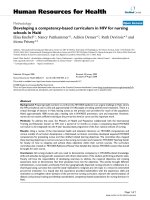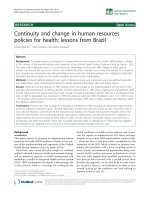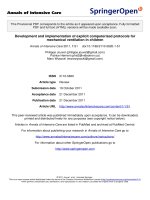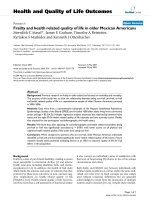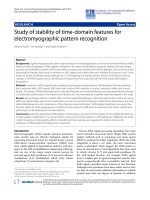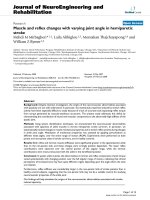Báo cáo toán học: " DWT and LPC based feature extraction methods for isolated word recognition" pptx
Bạn đang xem bản rút gọn của tài liệu. Xem và tải ngay bản đầy đủ của tài liệu tại đây (458.72 KB, 31 trang )
EURASIP Journal on Audio,
Speech, and Music Processing
This Provisional PDF corresponds to the article as it appeared upon acceptance. Fully formatted
PDF and full text (HTML) versions will be made available soon.
DWT and LPC based feature extraction methods for isolated word recognition
EURASIP Journal on Audio, Speech, and Music Processing 2012,
2012:7 doi:10.1186/1687-4722-2012-7
Navnath S Nehe ()
Raghunath S Holambe ()
ISSN
Article type
1687-4722
Research
Submission date
21 January 2011
Acceptance date
30 January 2012
Publication date
30 January 2012
Article URL
/>
This peer-reviewed article was published immediately upon acceptance. It can be downloaded,
printed and distributed freely for any purposes (see copyright notice below).
For information about publishing your research in EURASIP ASMP go to
/>For information about other SpringerOpen publications go to
© 2012 Nehe and Holambe ; licensee Springer.
This is an open access article distributed under the terms of the Creative Commons Attribution License ( />which permits unrestricted use, distribution, and reproduction in any medium, provided the original work is properly cited.
DWT and LPC based feature extraction methods for isolated word
recognition
Navnath S Nehe*1 and Raghunath S Holambe2
1
Department of Instrumentation Engineering, Pravara Rural Engineering
College, Loni 413736, Maharashtra, India
2
S.G.G.S. Institute Engineering & Technology, Vishnupuri, Nanded,
Maharashtra, India
*Corresponding author:
Email address:
RSH:
Abstract
In this article, new feature extraction methods, which utilize wavelet
decomposition and reduced order linear predictive coding (LPC)
coefficients, have been proposed for speech recognition. The coefficients
have been derived from the speech frames decomposed using discrete
wavelet transform. LPC coefficients derived from subband decomposition
(abbreviated as WLPC) of speech frame provide better representation than
modeling the frame directly. The WLPC coefficients have been further
normalized in cepstrum domain to get new set of features denoted as wavelet
subband cepstral mean normalized features. The proposed approaches
provide effective (better recognition rate), efficient (reduced feature vector
dimension), and noise robust features. The performance of these techniques
have been evaluated on the TI-46 isolated word database and own created
Marathi digits database in a white noise environment using the continuous
density hidden Markov model. The experimental results also show the
superiority of the proposed techniques over the conventional methods like
linear predictive cepstral coefficients, Mel-frequency cepstral coefficients,
spectral subtraction, and cepstral mean normalization in presence of additive
white Gaussian noise.
Keywords: feature extraction; linear predictive coding; discrete wavelet
transform; cepstral mean normalization; hidden Markov model.
1.
Introduction
A speech recognition system has two major components, namely, feature
extraction and classification. Feature extraction method plays a vital role in
speech recognition task. There are two dominant approaches of acoustic
measurement. First is a temporal domain or parametric approach such as
linear prediction [1], which is developed to closely match the resonant
structure of human vocal tract that produces the corresponding sound. Linear
prediction coefficients (LPC) technique is not suitable for representing
speech because it assumes signal stationary within a given frame and hence
not analyze the localized events accurately. Also it is not able to capture the
unvoiced and nasalized sounds properly [2]. Second approach is
nonparametric frequency domain approach based on human auditory
perception system and known as Mel-frequency cepstral coefficients
(MFCC) [3]. The widespread use of the MFCCs is due to its low
computational complexity and better performance for ASR under clean
matched conditions. Performance of MFCC degrades rapidly in presence of
noise and degradation is directly proportional to signal-to-noise ratio (SNR).
Poor performance of LPC and its different forms like reflection coefficients,
linear prediction cepstral coefficients (LPCC) as well as MFCC and its
various forms [4] in noisy conditions has led many researchers to investigate
alternative robust feature extraction algorithms.
In the literature, various techniques have been proposed to improve the
performance of ASR systems in the presence of noise. Speech enhancement
techniques such as spectral subtraction (SS) [5] or cepstrums from difference
of power spectrum [6] reduce the effect of noise either using statistical
information of noise or filtering the noise from noisy speech before feature
extraction. Techniques like perceptual linear prediction [7] and relative
spectra [8] incorporate some of the features of the human auditory
mechanism and give noise robust ASR. Feature enhancement techniques like
cepstral mean subtraction [9] and parallel model combination [10] improve
ASR performance by compensating for mismatch effects in cepstral domain
features.
In another approach [11–16] wavelet transform and wavelet packet tree
have been used for speech feature extraction in which the energies of
wavelet decomposed subbands have been used in place of Mel filtered
subband energies. Because of its better energy compaction property [17],
wavelet transform-based features give better recognition accuracy than LPC
and MFCC. Mel filter-like admissible wavelet packet structure [14]
performs better than MFCC in unvoiced phoneme recognition. Wavelet
subband features proposed in [15] used normalized subband energies as
features which show good performance in presence of additive white noise.
However, in these wavelet-based approaches, the time information is lost
due to use of wavelet subband energies. We used the actual wavelet
coefficients proposed in [18], which preserve the time information, and also
these features performed better than LPCC and MFCC due to the combined
advantages of LPC and WT. LPC can better distinguish words having
distinct vowel sounds [19] and WT can model the details of unvoiced sound
portions of speech signal. However, the performance of these features is not
well for the noisy speech recognition.
We propose the modification in the features proposed in [18] to derive
effective, efficient, and noise robust features from the frequency subbands of
the frame. Each frame of speech signal is decomposed (uniformly/dyadic)
into different frequency subbands using discrete wavelet transform (DWT)
and each subband is further modeled using linear predictive coding (LPC).
The WT has a better capability to model the details of unvoiced sound
portions. Hence, the subband decomposition has been performed by means
of DWT. DWT is more popular in the field of digital signal processing due
to its multiresolution capability and it has the property of constant Q, which
is one of the demands of many signal processing applications, especially in
the processing of the speech signals (as human’s hearing system is constant
Q perceptional) [20]. Wavelet decomposition results in a logarithmic set of
bandwidths, which is very similar to the response of human ear to
frequencies (logarithmic fashion). The LPC coefficients derived from the
speech subbands obtained after DWT decomposition provide WLPC
features [18]. Further these features were normalized in cepstrum domain
using well-known cepstrum mean normalization (CMN) technique to get the
noise robust features. These new features are denoted as wavelet subbandbased cepstral mean normalized features (WSCMN) which perform better in
additive white noise environment. The performance of the proposed features
is tested on TI-46 and Marathi digits database using continuous density
hidden Markov model (CDHMM) as a classifier.
The rest of the article is organized as follows. In Section 2, we describe a
brief theory about DWT. The proposed WLPC feature extraction and its
normalization are described in Section 3. The various experiments and
recognition results are given in Section 4. Section 5 gives the concluding
remarks based on the experimentation.
2.
Discrete wavelet transform
The speech is a nonstationary signal. The Fourier transform (FT) is not
suitable for the analysis of such nonstationary signal because it provides
only the frequency information of signal but does not provide the
information about at what time which frequency is present. The windowed
short-time FT (STFT) provides the temporal information about the
frequency content of signal. A drawback of the STFT is its fixed time
resolution due to fixed window length. The WT, with its flexible timefrequency window, is an appropriate tool for the analysis of nonstationary
signals like speech which have both short high frequency bursts and long
quasi-stationary components also.
WT decomposes signals over translated and dilated mother wavelets.
Mother wavelet is a time function with finite energy and fast decay. The
different versions of the single wavelet are orthogonal to each other. The
continuous wavelet transform (CWT) is given by Equation (1) where the
function ψ (t ) , a, and b are called the (mother) wavelet, scaling factor, and
translation parameter, respectively.
Wx (a, b) =
1
a
∞
∫ x(t )ψ
−∞
*
t −b
dt .
a
(1)
As CWT is a function of two parameters, it contains high redundancy
while analyzing the signals. Instead of this, analysis of the signal using small
number of scales with varying number of translations at each scale, i.e.,
discretizing scale and translation parameters as a = 2j and b = 2jk gives
DWT. DWT theory [20, 21] requires two sets of related functions called
scaling function and wavelet function given by
N −1
φ (t ) = ∑ h[n] 2φ (2t − n)
(2)
n=0
and
N −1
ψ (t ) = ∑ g[n] 2φ (2t − n) ,
(3)
n=0
where function φ (t ) is called scaling function, h[n] is an impulse response of
a low-pass filter, and g[n] is an impulse response of a high-pass filter. The
scaling and wavelet functions can be implemented effectively using a pair of
filters, i.e., h[n] and g[n]. These filters are called a quadrature mirror filters
1−n
that satisfy the property g[n] = ( −1) h[1 − n] [17]. The input signal is low-pass
filtered to give the approximate components and high-pass filtered to give
the detail components of the input speech signal. The approximate signal at
each stage is further decomposed using same low-pass and high-pass filters
to get the approximate and detail components for the next stage. This type of
decomposition is called dyadic decomposition, whereas decomposition of
detail signal along with the approximate signal at each stage is called
uniform decomposition. Dyadic decomposition divides the input signal
bandwidth into the logarithmic set of bandwidths, whereas the uniform
decomposition divides it into the uniform set of bandwidths.
In speech signal, high frequencies are present very briefly at the onset of
a sound while lower frequencies are present latter for long period [21]. DWT
resolves all these frequencies well. The DWT parameters contain the
information of different frequency scales. This helps in getting the speech
information of corresponding frequency band. In order to parameterize the
speech signal, the signal is decomposed into four frequency bands uniformly
or in dyadic fashion.
3.
Proposed WLPC feature extraction
Among the speech recognition approaches, the family based on LPC
coefficient and their cepstrum (LPCC) is well known for its performance and
relative simplicity. LPC are the coefficients of an auto-regressive model [2]
of a speech frame. The all-pole representation of the vocal tract transfer
function is as given below
H ( z) =
G
(4)
p
1 − ∑ ai z
−i
i =1
where ap are the prediction coefficients and G is the gain. These LPC can be
derived by minimizing the mean square error between the actual samples of
speech frame and the estimated samples by autocorrelation method. LPCC
were obtained directly using Equation (5) [2].
i −1
k −i
LPCCi = ai + ∑
LPCCi − k ak
i
k =1
(5)
where i = 1,2,…,p. The obtained LPC and LPCC features cannot capture the
high frequency peaks present in the speech signal and also cannot analyze
the localized events accurately which wavelet transform can analyze.
However, LPC can better distinguish between the words that have distinct
vowel sounds than those share common vowel sounds [19]. WT is able to
model the details of unvoiced sound portion of speech than LPC [19]. Also
subband signals (wavelet coefficients) obtained from the wavelet
decomposition can preserve the time information [12] and LPC can be
estimated from such time domain signals easily. So, we can apply LPC
technique on each subband signal after the wavelet decomposition which
gives the combined benefits of LPC and WT. Hence, the combination of
LPC with WT has been proposed in this article.
The LPCC features have been estimated from the subband signals obtained
from the DWT in the proposed feature extraction technique. Figure 1 shows
the block diagrams of proposed feature extraction systems. Three levels
DWT decomposition of preprocessed and windowed speech frames has been
done using Daubechies’s wavelet filters. Actual wavelet coefficients retain
the time information; hence, LPC features have been estimated from the
DWT coefficients in time domain. LPC features of pth order have been
extracted from each subband of wavelet decomposed speech signal. The
LPC coefficients obtained from each subband are concatenated to form a
final feature vector denoted as Dyadic wavelet decomposed LPC (DWLPC).
Thus, the feature vector fi derived from frame i can be expressed as
fi = [aA3
aD3
aD2
aD1 ]T ,
(6)
where, a A is a row vector formed using prediction coefficients obtained
3
from the approximate components A3 at third level and aD is row vector
j
formed using prediction coefficients obtained from the detail components D j
(j = 1,2,3) at jth level. T indicates a vector transpose.
Figure 1b shows the schematic of uniform wavelet decomposed LPC
(UWLPC) feature extraction from subbands of uniform bandwidth. The
subbands are obtained by two-level wavelet packet decomposition [21].
Then, the UWLPC feature vector is formed similar to DWLPC by
concatenation of LPC coefficients estimated from the uniformly
decomposed subband signals.
3.1.
WSCMN features
CMN [9] is the simplest feature normalization technique to implement. It
provides many of the benefits available in the more-advanced normalization
algorithms. The LPCC cepstrums were derived using Equation (5) from the
WLPC features estimated from the subband signals of each frame. Thus, a
sequence of cepstral vectors {x1 , x2 ,..., xT } is obtained from a speech sample.
Further these cepstral vectors were normalized using CMN. In its basic
form, CMN consists of subtracting the mean feature vector µ x from each
ˆ
vector xt and normalizing by variance σ x to obtain the normalized vector xt .
ˆ
xt =
xt − µ x
(7)
σx
where
µx =
1
∑ xt
T t
and
σ x2 =
1 T
∑ ( xt2 − µ x2 ) .
T t =1
(8)
This gives the proposed WSCMN feature vectors. Figure 2 shows the
WSCMN feature extraction steps where U-WSCMN are the uniform
decomposed WSCMN feature vectors and D-WSCMN are the dyadic
decomposed WSCMN feature vectors.
After normalization, the mean of the cepstral sequence is zero, and it has
a variance of one. This normalization is also called as cepstral mean and
variance normalization. The CMN makes the features robust to some linear
filtering of the acoustic signal, which might be caused by microphones with
different transfer functions, varying distance from user to microphone, the
room acoustics, or transmission channels [9].
4.
Experimental results
This section evaluates the performance of the proposed techniques on
isolated words in presence of stationary white noise using TI-46 and own
created Marathi databases.
4.1 Databases
The speech recognition experiments were conducted under clean and noisy
conditions using the TI-46 and own created Marathi digit database. The TI46 Speaker Dependent Isolated Word Corpus [22] has two datasets, namely,
TI-20 and TI-ALPHA. The TI-20 vocabulary consists of ten English digits
“zero” through “nine” and ten control words “yes, no, erase, rubout, repeat,
go, enter, help, stop, and start”. The TI-ALPHA subset consists of “a”
through “z” English alphabets. In both the subsets, data are collected from
eight male and eight female speakers. There are 26 utterances of each word
from each speaker out of which 10 were used as training tokens and
remaining 16 were used as testing tokens. So, TI-20 subset has total 3200
training samples and 5120 test samples, whereas TI-ALPHA has 4160
training samples and 6656 test samples. All the data samples were digitized
with sampling frequency 12.5 kHz.
For Marathi database, data were collected from 56 male and 44 female
speakers in a quiet room and discretized with sampling frequency 10 kHz.
There are 20 utterances of each word from each speaker recorded in 2
different sessions at an interval of 1 week. The samples were recorded in
two different sessions with a gap of 1 week between two sessions. In each
session, ten utterances of each word from each speaker were recorded. For
experiments, the samples recorded in first session were used for training and
the samples recorded in second session were used for testing. Thus, this
database has total 10,000 training samples and 10,000 test samples. Table 1
shows the English digits and their equivalent Marathi digit pronunciation.
4.2 Experimental setup
The input speech samples are pre-emphasized by a first-order filter with
transfer function H(z) = 1–0.97z–1. The pre-emphasized speech data are
divided into blocks of 25.6 ms duration with 50% overlap between every
adjacent frame. The smooth frequency transitions are ensured using a
Hamming window to each frame.
Noisy test samples of each dataset (TI-20, TI-ALPHA, and Marathi
Digits) were obtained by artificially adding stationary white Gaussian noise
under a wide range of SNRs (0, 5, 10, 15, 20, and 30 dB) into the test
samples of each dataset. Tests were carried out on clean as well as noisy test
samples. For training and testing, diagonal covariance left–right CDHMM
[2] with 4-mixtures and 5-states (as this combination yields best
performance) was used as a classifier.
4.3 Baseline experiment
The baseline experiments were performed using LPCC and MFCC
features on each database. First in the LPCC feature extraction, the
prediction coefficients were extracted from each speech frame using 13th
order LPC. From the obtained prediction coefficients, cepstral coefficients
and its temporal derivatives (first and second derivatives) were extracted and
concatenated to form a final LPCC feature vector (this gives feature
dimension 39).
In MFCC feature extraction process, the magnitude spectrum of
windowed speech frame was filtered using a triangular Mel filter bank
consisting of 20 Mel filters. From a set of 20 Mel-scaled log filter bank
outputs, MFCC feature vector that consists of 13 MFCC and the
corresponding delta and acceleration coefficients (total 39 coefficients) is
extracted from each frame. The performance of LPCC and MFCC features
was tested on each dataset under clean test condition and presented in
Table 2. The recognition results obtained using MFCC features (under clean
test condition) are comparable to the state-of-the-art recognition results
presented in [23]. These results are used as a baseline for the comparison.
We tested the performance of LPCC and MFCC features for different
LPC orders and different number of Mel-filters in the triangular filter bank,
respectively. It was observed that 13th-order LPC (p = 13), 20 Mel-filters in
filter bank, and feature vector of length 39 (13 LPC/MFCC coefficients and
their first and second derivatives) yield best performance on the databases.
Hence, the results were obtained for these values of parameters.
4.4 WLPC features
In this section, features were extracted using proposed techniques. In the
first type, each speech frame was decomposed into subbands of logarithmic
bandwidth by three level DWT and 32nd-order Daubechies’s wavelet (the
algorithms were tested for various orders and it is observed that 32nd order
gives the best performance). Prediction coefficients with different LPC
orders (varying from 3 to 7) were derived from the subbands. These
prediction coefficients were then concatenated to form DWLPC feature
vector. In the second type, each speech frame was decomposed into
subbands of uniform bandwidth by two level wavelet packet transform.
Then, the prediction coefficients were estimated from the subbands of
uniform decomposition similar to first type and were concatenated to form
UWLPC feature vector. In both the feature extraction types, we select LPC
of order 5 (as it gives the best performance). Five prediction coefficients
from each subband give feature vector of dimension 20. Performances of
these features were tested using CDHMM with 4-mixtures and 5-states. For
the comparison of performance based on the feature dimension, we also
considered the 21 coefficients in LPCC and MFCC feature vectors (7
LPC/MFCC coefficients and their first and second derivatives). The
performances of LPCC, MFCC, and WLPC (UWLPC/ DWLPC) features
have been tested on TI-20 database and presented in Table 3.
Percentage
recognition
rate
using
LPCC
and
WLPC
(UWLPC/DWLPC) features for different LPC order were also estimated and
presented in Figure 3. These results prove that the performance of WLPC
(UWLPC/DWLPC) is better than LPCC and MFCC features with half the
feature vector length than LPCC and MFCC because the proposed features
combine the advantage of identification capability of LPC for vowel and the
wavelet’s better modeling capability of unvoiced sound portions and high
frequency picks of speech sound. Among the WLPC features, DWLPC is
superior to UWLPC because the dyadic decomposition in DWLPC mimics
the human auditory perception system better.
The performance of MFCC and WLPC (UWLPC and DWLPC)
features on TI-Alpha database has been presented in Table 4.
Further, the robustness of the proposed features has been tested by
normalizing the features using CMN. The CMN is applied on the WLPC to
get the noise robust WSCMN (D-WSCMN and U-WSCMN) features for the
isolated word recognition. The performance of the D-WSCMN for different
prediction orders (p) was tested on clean TI-20 database and is presented in
Figure 4. From these results it is clear that the D-WSCMN yield better
results for p = 5. The robustness of WSCMN features was tested on noisy
samples generated by adding white Gaussian noise (of SNR 0, 5, 10, and
20 dB) to the test samples of TI-20 dataset. The results of WSCMN features
were compared with LPCC, MFCC, SS method [5], and CMN [9] features in
Figure 5.
WSCMN feature performance was also tested on clean as well as
noisy Marathi digits database. The recognition performance of WSCMN
using uniform and dyadic decomposition on this database is shown in
Figure 6. It is observed that as compared to MFCC performance on clean
data (84.50%), the performance of WSCMN features is significantly
increased (100%) on this database. This is because the WSCMN technique is
able to capture the difference between the Marathi phonemes more clearly
than the MFCC and CMN. Also it gives better performance at various noise
levels because of the cepstrum normalization.
5.
Conclusions
In this article, DWT and LPC-based techniques (UWLPC and DWLPC) for
isolated word recognition have been presented. Experimental results show
that the proposed WLPC (UWLPC and DWLPC) features are effective and
efficient as compared to LPCC and MFCC because it takes the combined
advantages of LPC and DWT while estimating the features. Feature vector
dimension for WLPC is almost half of the LPCC and MFCC. This reduces
the memory requirement and the computational time. It is also observed that
the performance of DWLPC is better than UWLPC. This is because the
dyadic (logarithmic) frequency decomposition mimics the human auditory
perception system better than uniform frequency decomposition.
WSCMN features are noise robust features because of normalization in
cepstrum domain. It is observed that the proposed WSCMN features yield
better performance as compared to the popular existing methods in presence
of white noise because this technique is able to capture the difference
between the phonemes (especially in Marathi database) more clearly than
the MFCC and CMN. It has also been proved experimentally that the
proposed approaches provide effective (better recognition rate), efficient
(reduced feature vector dimension), and robust features.
Competing interests
The authors declare that they have no competing interests.
References
[1] F Itakura, Minimum prediction residual principle applied to speech
recognition. IEEE Trans. Acoust. Speech Signal Proces. ASSP-23, 67–
72 (1975)
[2] L Rabiner, BH Juang, Fundamentals of Speech Recognition (PrenticeHall Inc., Englewood Cliffs, NJ, 1993)
[3] SB Davis, P Mermelstein, Comparison of parametric representations for
monosyllabic word recognition in continuously spoken sentences. IEEE
Trans. Acoust. Speech Signal Process. ASSP-28(4), 357–366 (1980)
[4] K Wang, CH Lee, BH Juang, Selective feature extraction via signal
decomposition. IEEE Signal Process. Lett. 4, 8–11 (1997)
[5] SF Boll, Suppression of acoustic noise in speech using spectral
subtraction. IEEE Trans. Acoust. Speech Signal Process. 27, 113–120
(1979)
[6] J Xu, G Wei, Noise-robust speech recognition based on difference of
power spectrum. Electron. Lett. 36(14), 1247–1248 (2000)
[7] H Hermansky, Perceptual linear predictive (PLP) analysis of speech. J.
Acoust. Soc. Am. 87(4), 1738–1752 (1990)
[8] H Hermansky, N Morgan, RASTA processing of speech. IEEE Trans.
Speech Audio Process. 2, 578–589 (1994)
[9] AE Rosenberg, CH Lee, FK Soong, Cepstral channel normalization
techniques for hmm-based speaker verification, in Proc. ICSLP,
Yokohama, Japan, 1994, pp. 1835–1838
[10] MJF Gales, SJ Young, Robust speech recognition using parallel model
combination. IEEE Trans. Speech Audio Process. 4, 352–359 (1996)
[11] Z Tufekci, JN Gowdy, Feature extraction using discrete wavelet
transform for speech recognition, in IEEE International Conference
Southeastcon 2000, Nashville, TN, USA, April 2000, pp. 116–123
[12] M Gupta, A Gilbert, Robust speech recognition using wavelet
coefficient features, in Proc. IEEE workshop on Automatic Speech
Recognition and Understanding (ASRU’01), Madonna di Campiglio,
Trento, Italy, December 2001, pp. 445–448
[13] JN Gowdy, Z Tufekci, Mel-scaled discrete wavelet coefficients for
speech recognition, in Proc. IEEE Inter. Conf. Acoustics, speech, and
Signal Processing (ICASSP’00), vol. 3, Istanbul, Turkey, June 2000, pp.
1351–1354
[14] O Farooq, S Datta, Mel filter-like admissible wavelet packet structure
for speech recognition. IEEE Signal Process. Lett. 8(7), 196–198 (2001)
[15] O Farooq, S Datta, Wavelet based robust sub-band features for
phoneme recognition. IEE Vis. Image Signal Process. 151(4), 187–193
(2004)
[16] B Kotnik, Z Kačič, A comprehensive noise robust speech
parameterization algorithm using wavelet packet decomposition-based
denoising and speech feature representation techniques. EURASIP J.
Adv. Signal Process. 1, 1–20 (2007)
[17] S Mallat, A Wavelet Tour of Signal Processing (Academic, New York,
1998)
[18] NS Nehe, RS Holambe, New feature extraction methods using DWT
and LPC for isolated word recognition, in Proc. of IEEE TENCON 2008,
Hyderabad, India, 2008, pp. 1–6
[19] M Krishnan, CP Neophytou, G Prescott, Wavelet transform speech
recognition using vector quantization, dynamic time warping and
artificial neural networks, in International Conference On Spoken
Language Processing, Yokohama, Japan, 1994, pp. 1191–1193
[20] Y Hao, X Zhu, A new feature in speech recognition based on wavelet
transform, in Proc. IEEE 5th Inter. Conf. on Signal Processing (WCCCICSP 2000), Beijing, China, vol 3, 21–25 August 2000, pp. 1526–1529
[21] KP Soman, KI Ramchandran, Insight into Wavelets from Theory to
Practice, 2nd edn. (Prentice-Hall of India, New Delhi, 2005)
[22] TI 46-Word Speaker-Dependent Isolated Word Corpus, NIST Speech
Disc 7-1.1, 1991
[23] DS Pallett, A benchmark for speaker-dependent recognition using the
Texas Instruments 20 Word and Alpha-set speech database, in Proc. of
Speech Recognition Workshop, Bristol, UK, 1986, pp. 67–72
Figure 1. WLPC Feature extraction methods: (a) DWLPC; (b) UWLPC.
Figure 2. WSCMN Feature extraction methods.
Figure 3. Percentage recognition rate for different LPC orders using (a)
LPCC features, (b) WLPC (UWLPC/DWLPC) features.
Figure 4. D-WSCMN performance for different LPC orders p on clean
TI-20 database.
Figure 5. Percentage recognition rate of different features on TI-20
database in white noise environment.
Figure 6. Performance of WSCMN features on Marathi digit database
in white noise environment.
Table 1. English and equivalent Marathi digit pronunciation
Zero
One Two Three Four Five
Shunya Ek
Don
Teen
Six
Seven Eight Nine
Char Paach Saha Sat
Aath
Nau
Table 2. Percentage recognition rate of LPCC and MFCC features on
various datasets
% Recognition rate
Dataset
LPCC
MFCC
TI-20
97.2
98.2
TI-ALPHA
80.6
85.8
Marathi Digits 78.9
84.5
Table 3. Percentage recognition rates of different features on TI-20
database.
Features Feature vector length
% Recognition rate
LPCC
39
97.2
21
92.9
39
98.2
21
96.2
UWLPC 20
98.9
DWLPC 20
99.1
MFCC
Table 4. Performance of WLPC features on TI-Alpha database
Features Feature vector length
% Recognition rate
MFCC
39
84.1
UWLPC
20
85.2
DWLPC
20
87.0



